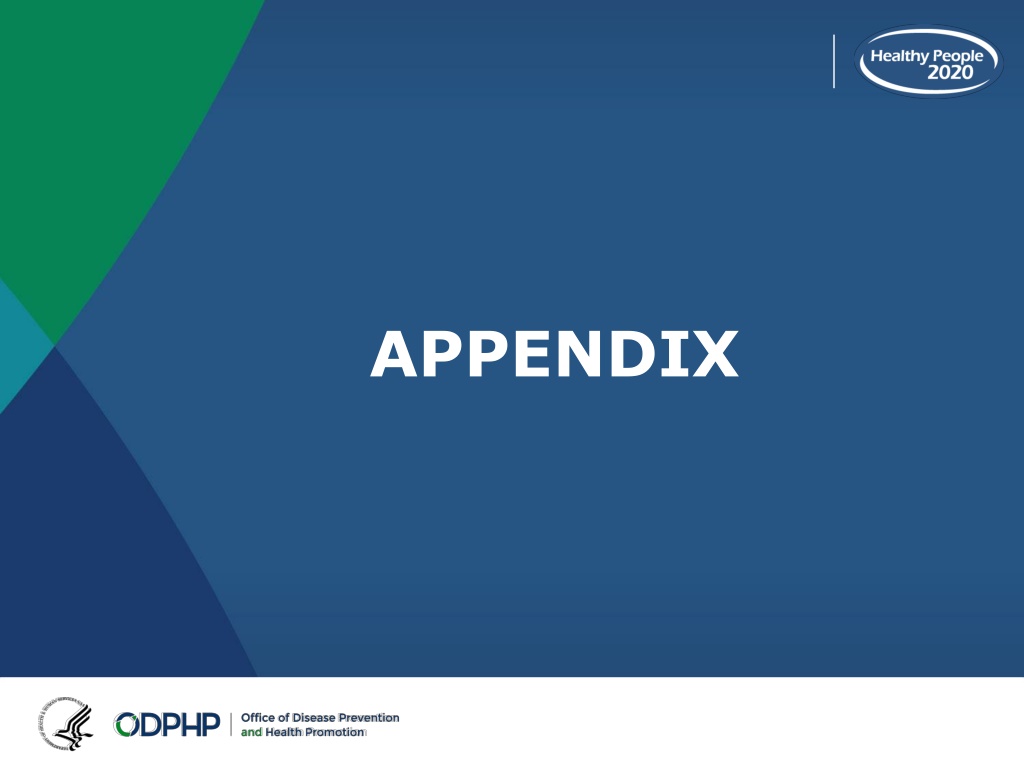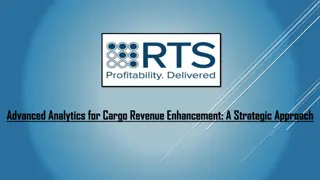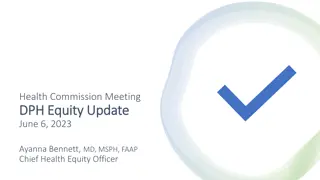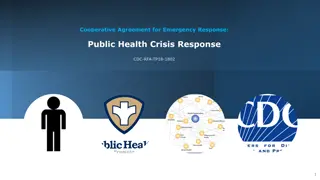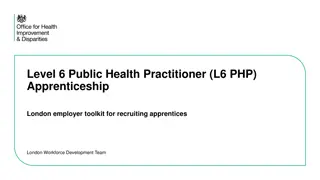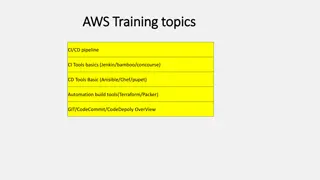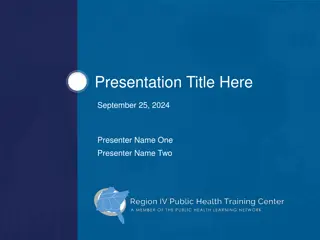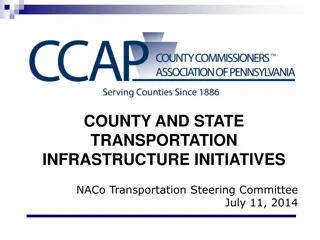Public Health Infrastructure Enhancement Initiatives
The document outlines objectives aimed at enhancing the public health infrastructure, including workforce development, educational integration, data systems improvement, and organizational advancements. Objectives range from incorporating core competencies into job descriptions to increasing the number of public health degrees awarded and improving data collection for Healthy People 2020 objectives.
Download Presentation

Please find below an Image/Link to download the presentation.
The content on the website is provided AS IS for your information and personal use only. It may not be sold, licensed, or shared on other websites without obtaining consent from the author. Download presentation by click this link. If you encounter any issues during the download, it is possible that the publisher has removed the file from their server.
E N D
Presentation Transcript
Objective Status: Public Health Infrastructure Target met Improving Little/No change Getting worse Baseline only Developmental Informational Public Health Workforce PHI-1.2 (Developmental) Increase the proportion of tribal public health agencies that incorporate Core Competencies for Public Health Professionals into job descriptions and performance evaluations PHI-1.3.1 Increase the proportion of state public health agencies that incorporate Core Competencies for Public Health Professionals into job descriptions PHI-1.3.2 Increase the proportion of state public health agencies that incorporate Core Competencies for Public Health Professionals into performance evaluations PHI-1.4.1 Increase the proportion of local public health agencies that incorporate Core Competencies for Public Health Professionals into job descriptions PHI-1.4.2 Increase the proportion of local public health agencies that incorporate Core Competencies for Public Health Professionals into performance evaluations PHI-2.1 (Developmental) Increase the proportion of tribal public health agencies that use Core Competencies for Public Health Professionals in continuing education for personnel PHI-2.2 Increase the proportion of state public health agencies that use Core Competencies for Public Health Professionals in continuing education for personnel PHI-2.3 Increase the proportion of local public health agencies that use Core Competencies for Public Health Professionals in continuing education for personnel PHI-3 Increase the proportion of Council on Education for Public Health (CEPH) accredited schools of public health, CEPH accredited academic programs, and schools of nursing (with a public health or community health component) that integrate Core Competencies for Public Health Professionals into curricula
Objective Status: Public Health Infrastructure Target met Improving Little/No change Getting worse Baseline only Developmental Informational PHI-4.1 Increase the number of public health or related graduate degrees and post- baccalaureate certificates awarded PHI-4.2 Increase the number of public health or related bachelor s degrees awarded PHI-5 (Developmental) Increase the proportion of 4-year colleges and universities that offer public health or related majors and/or minors that are consistent with the core competencies of undergraduate public health education PHI-6.1 Increase the number of public health or related sub-baccalaureate certificates and associate degrees awarded Data and Information Systems PHI-7.1 Increase the proportion of population-based Healthy People 2020 objectives for which national data are available by race and ethnicity PHI-7.2 Increase the proportion of population-based Healthy People 2020 objectives for which national data are available by sex PHI-7.3 Increase the proportion of population-based Healthy People 2020 objectives for which national data are available by socioeconomic status PHI-8.1 Increase the proportion of Healthy People 2020 objectives that have at least one data point PHI-8.2 Increase the proportion of Healthy People 2020 objectives that have at least two data points PHI-8.3 Increase the proportion of Healthy People 2020 objectives that are tracked at least every 3 years
Objective Status: Public Health Infrastructure Target met Improving Little/No change Getting worse Baseline only Developmental Informational PHI-9 Increase the proportion of Healthy People 2020 objectives for which national data are released within 1 year of the end of data collection PHI-10.1 Increase the number of states that record vital events using the latest U.S. standard certificate of birth PHI-10.2 Increase the number of states that record vital events using the latest U.S. standard certificate of death PHI-10.3 Increase the number of states that record vital events using the latest U.S. standard report of fetal death Public Health Organizations PHI-11.1 Increase the proportion of tribal and state public health agencies that provide or assure comprehensive laboratory services to support disease prevention, control, and surveillance PHI-11.2 Increase the proportion of tribal and state public health agencies that provide or assure comprehensive laboratory services that incorporate integrated data management PHI-11.3 Increase the proportion of tribal and state public health agencies that provide or assure comprehensive laboratory services that support reference and specialized testing PHI-11.4 Increase the proportion of tribal and state public health agencies that provide or assure comprehensive laboratory services in support of environmental health and protection PHI-11.5 Increase the proportion of tribal and state public health agencies that provide or assure comprehensive laboratory services in support of food safety
Objective Status: Public Health Infrastructure Target met Improving Little/No change Getting worse Baseline only Developmental Informational PHI-11.6 Increase the proportion of tribal and state public health agencies that provide or assure comprehensive laboratory services that advance laboratory improvement and regulation PHI-11.7 Increase the proportion of tribal and state public health agencies that provide or assure comprehensive laboratory services that support policy development PHI-11.8 Increase the proportion of tribal and state public health agencies that provide or assure comprehensive laboratory services in support of emergency response PHI-11.9 Increase the proportion of tribal and state public health agencies that provide or assure comprehensive laboratory services in support of public health-related research PHI-11.10 Increase the proportion of tribal and state public health agencies that provide or assure comprehensive laboratory services that support training and education PHI-11.11 Increase the proportion of tribal and state public health agencies that provide or assure comprehensive laboratory services that foster partnerships and communication PHI-12.1 Increase the proportion of public health laboratory systems (including State, Tribal, and local) that perform at a high level of quality in the monitoring of health status to identify and solve community health problems PHI-12.2 Increase the proportion of public health laboratory systems (including State, Tribal, and local) that perform at a high level of quality in support of diagnosing and investigating health problems and health hazards in the community PHI-12.3 Increase the proportion of public health laboratory systems (including State, Tribal, and local) that perform at a high level of quality with respect to informing, educating, and empowering people about health issues
Objective Status: Public Health Infrastructure Target met Improving Little/No change Getting worse Baseline only Developmental Informational PHI-12.4 Increase the proportion of public health laboratory systems (including State, Tribal, and local) that perform at a high level of quality in mobilizing community partnerships and action to identify and solve health problems PHI-12.5 Increase the proportion of public health laboratory systems (including State, Tribal, and local) that perform at a high level of quality in developing policies and plans that support individual and community health efforts PHI-12.6 Increase the proportion of public health laboratory systems (including State, Tribal, and local) that perform at a high level of quality in the enforcement of laws and regulations that protect health and ensure safety PHI-12.7 Increase the proportion of public health laboratory systems (including State, Tribal, and local) that perform at a high level of quality in linking people to needed personal health services and assure the provision of health care when otherwise unavailable PHI-12.8 Increase the proportion of public health laboratory systems (including State, Tribal, and local) that perform at a high level of quality in assuring a competent public and personal health care workforce PHI-12.9 Increase the proportion of public health laboratory systems (including State, Tribal, and local) that perform at a high level of quality in evaluating effectiveness, accessibility, and quality of personal and population-based health services PHI-12.10 Increase the proportion of public health laboratory systems (including State, Tribal, and local) that perform at a high level of quality in supporting research into new insights and innovative solutions to health problems
Objective Status: Public Health Infrastructure Target met Improving Little/No change Getting worse Baseline only Developmental Informational PHI-13.1 Increase the proportion of State Epidemiologists with formal training in epidemiology in State public health agencies PHI-13.2 (Developmental) Increase the proportion of Tribal public health agencies that provide or assure comprehensive epidemiology services to support essential public health services PHI-13.3 Increase the proportion of State public health agencies that provide or assure comprehensive epidemiology services to support essential public health services PHI-13.4 Increase the proportion of local public health agencies that provide or assure comprehensive epidemiology services to support essential public health services PHI-14.1 Increase the proportion of State public health systems that conduct a public health system assessment using national performance standards PHI-14.2 Increase the proportion of local public health systems that conduct a public health system assessment using national performance standards PHI-15.1 (Developmental) Increase the proportion of Tribal agencies that have developed a health improvement plan PHI-15.2 Increase the proportion of State public health agencies that have developed a health improvement plan PHI-15.3 Increase the proportion of local public health agencies that have developed a health improvement plan PHI-15.4 Increase the proportion of local public health agencies that have health improvement plans linked to their State plan
Objective Status: Public Health Infrastructure Target met Improving Little/No change Getting worse Baseline only Developmental Informational PHI-16.1 (Developmental) Increase the proportion of Tribal public health agencies that have implemented an agency-wide quality improvement process PHI-16.2 Increase the proportion of State public health agencies that have implemented an agency-wide quality improvement process PHI-16.3 Increase the proportion of local public health agencies that have implemented an agency-wide quality improvement process PHI-17.1 Increase the number of Tribal public health agencies that are accredited PHI-17.2 Increase the proportion of State public health agencies that are accredited PHI-17.3 Increase the proportion of local public health agencies that are accredited
Current HP2020 Objective Status: Public Health Infrastructure Measurable objectives: 54 Informational 5.6% (n = 3) Baseline only 7.4% (n = 4) Total objectives: 63 Getting worse 3.7% (n = 2) Little or no detectable change 5.6% (n = 3) Developmental 9.5% (n = 6) Improving 20.4% (n = 11) Target met or exceeded 57.4% (n = 31) Measurable 85.7% (n = 54) Archived 4.8% (n = 3) NOTE: Progress current as of 03/23/2018.
Objective Status: Preparedness Target met Improving Little/No change Getting worse Baseline only Developmental Informational PREP-1 (Developmental) Reduce the time necessary to issue official information to the public about a public health emergency PREP-2 Reduce the time necessary to activate designated personnel in response to a public health emergency PREP-4 Reduce the time for State public health agencies to establish after action reports and improvement plans following responses to public health emergencies and exercises PREP-5.1 Increase the percentage of school districts that required schools to include family reunification plans PREP-5.2 Increase the percentage of school districts that required schools to include procedures for responding to pandemic flu or other infectious disease outbreaks PREP-5.3 Increase the percentage of school districts that required schools to include specific provisions for students and staff with special needs PREP-5.4 Increase the percentage of school districts that required schools to include specific provisions for mental health services for students, faculty, and staff after a crisis has occurred PREP-6 (Developmental) Increase the proportion of parents and/or guardians aware of the emergency or evacuation plan in their child(ren)'s school including the evacuation location and how to get information about the child in the event of a disaster PREP-7 Increase the proportion of adults residing with children attending school who have an emergency plan and have household discussions of that emergency plan PREP-8 (Developmental) Increase the proportion of adults who engage in preparedness activities for a widespread outbreak of a contagious disease after recently receiving preparedness information on outbreaks
Objective Status: Preparedness Target met Improving Little/No change Getting worse Baseline only Developmental Informational PREP-9 (Developmental) Increase the proportion of adults who are aware of their transportation support needs to evacuate in preparation of a hurricane, flood, or wildfire PREP-10 (Developmental) Increase the proportion of adults who know how to obtain real- time alerts and warnings for disasters in their community PREP-11 (Developmental) Increase the proportion of adults who received information about disaster preparedness in the last 6 months PREP-12 (Developmental) Increase the proportion of adults who have taken actions to prepare for a possible disaster or emergency within 6 months after being made aware of preparedness information PREP-13 Increase the proportion of adults whose household has an emergency plan that includes instructions for household members about where to go and what to do in the event of a disaster PREP-14 (Developmental) Increase the number of states with statewide protocols or triage guidelines for EMS personnel during mass casualty situations PREP-15.1 Increase the rate of bystander CPR for all non-traumatic cardiac arrests PREP-15.2 Increase the rate of bystander AED use for non-traumatic cardiac arrests occurring in public locations PREP-15.3 Increase the rate of survival to hospital discharge for all patients who receive bystander intervention through CPR and/or AED application PREP-15.4 Increase the rate of survival to hospital discharge for patients that have a bystander witnessed non-traumatic cardiac arrest that presents in a shockable rhythm and who receive bystander intervention through CPR and/or AED application
Objective Status: Preparedness Target met Improving Little/No change Getting worse Baseline only Developmental Informational PREP-16.1 Increase the percentage of Medical Reserve Corps (MRC) units participating in preparedness training and exercise activities PREP-16.2 Increase the percentage of Medical Reserve Corps (MRC) units participating in public health activities PREP-16.3 Increase the percentage of Medical Reserve Corps (MRC) units compliant with the National Incident Management System (NIMS) PREP-17.1 Increase the number of preparedness training and exercise activities in which Medical Reserve Corps (MRC) units participate PREP-17.2 Increase the number of public health activities in which Medical Reserve Corps (MRC) units participate PREP-18.1 Increase the overall membership of HPP-funded Healthcare Coalitions PREP-19 Increase the number of states reporting 90% of emergency medical services (EMS) calls to the National EMS Information System (NEMSIS) using the currently accepted dataset standard PREP-20.1 Increase the number of states that require regulated child care providers to have an evacuation plan that includes a relocation site PREP-20.2 Increase the number of states that require regulated child care providers to have a plan to reunite families after a disaster in the event of a relocation PREP-20.3 Increase the number of states that require regulated child care providers to have an emergency plan for children with access and functional needs including disabilities
Current HP2020 Objective Status: Preparedness NOTE: Progress current as of 03/23/2018.
